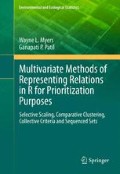Abstract
We return now to the context of Chap. 3 where rotational rescaling was introduced and then exploited in the manner of principal components via the princomp() function facility of R. We generalize that work to encompass linear transformation of multiple measures to generate a secondary set of what we will call virtual variates. We reserve the term virtual variates for situations in which the transformation is reversible so that the original multiple measures can be reproduced from the secondary set through a suitable transformation. In such circumstances, the transformation effectively provides a particular perspective from which to view the data without loss of information. With principal components, the perspective was one of independent (uncorrelated) dimensions (Raykov 2008; Timm 2002; Hair et al. 2010). In the earlier venture, we did not undertake to reverse the principal component transformation, but will do so in the course of current consideration. Virtual variates from principal components are also not the only interesting perspectives of this nature to be explored (Johnson and Wichern 2007; Sengupta 2003; Mukhopadhyay 2009), and linear transformations will entail several additional operators in R.
Access this chapter
Tax calculation will be finalised at checkout
Purchases are for personal use only
References
Afifi A, Clark V, May S (2004) Computer-aided multivariate analysis. Chapman & Hall/CRC, Boca Raton, FL
Giri N (2004) Multivariate statistical analysis. Marcel Dekker, New York
Hair J, Babin B, Anderson R (2010) Multivariate data analysis. Prentice-Hall, Upper Saddle River, NJ
Johnson R, Wichern D (2007) Applied multivariate analysis. Prenticed-Hall, Upper Saddle River, NJ
Mukhopadhyay P (2009) Multivariate statistical analysis. World Scientific, Hackensack, NJ
Rencher A (2002) Methods of multivariate analysis. Wiley-Interscience, New York
Raykov T (2008) An introduction to applied multivariate analysis. Routledge/Taylor & Francis, London
Sengupta D (2003) Linear models: an integrated approach. World Scientific, Hackensack, NJ
Timm N (2002) Applied multivariate analysis. Springer, New York
Author information
Authors and Affiliations
Rights and permissions
Copyright information
© 2012 Springer Science+Business Media, LLC
About this chapter
Cite this chapter
Myers, W.L., Patil, G.P. (2012). Matrix Methods for Multiple Measures. In: Multivariate Methods of Representing Relations in R for Prioritization Purposes. Environmental and Ecological Statistics, vol 6. Springer, New York, NY. https://doi.org/10.1007/978-1-4614-3122-0_13
Download citation
DOI: https://doi.org/10.1007/978-1-4614-3122-0_13
Published:
Publisher Name: Springer, New York, NY
Print ISBN: 978-1-4614-3121-3
Online ISBN: 978-1-4614-3122-0
eBook Packages: Earth and Environmental ScienceEarth and Environmental Science (R0)

